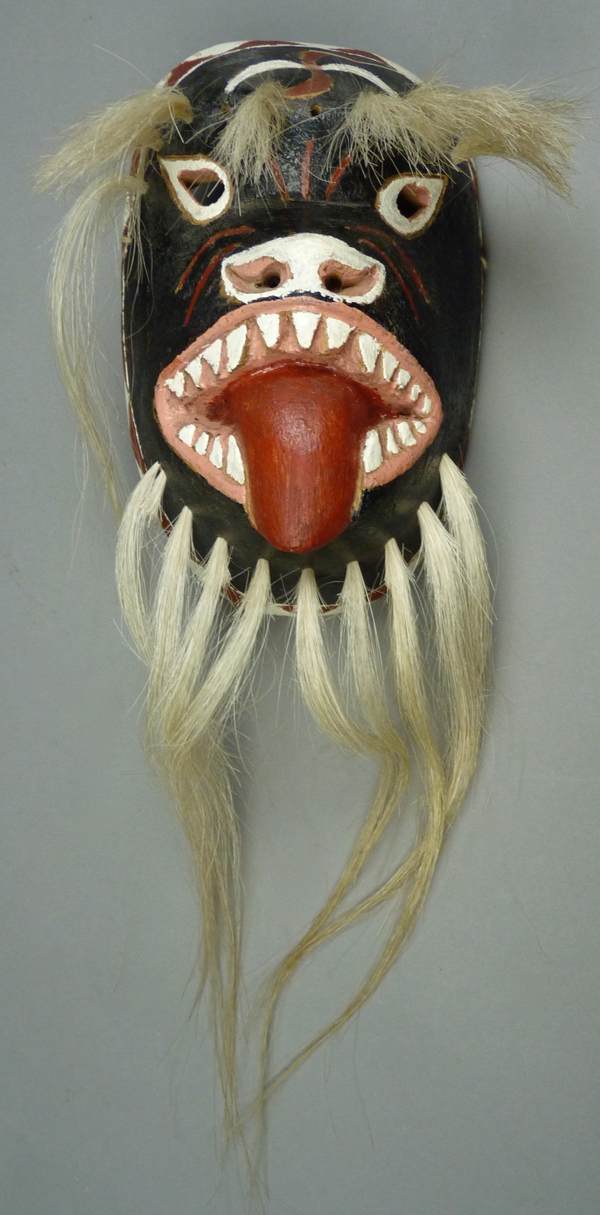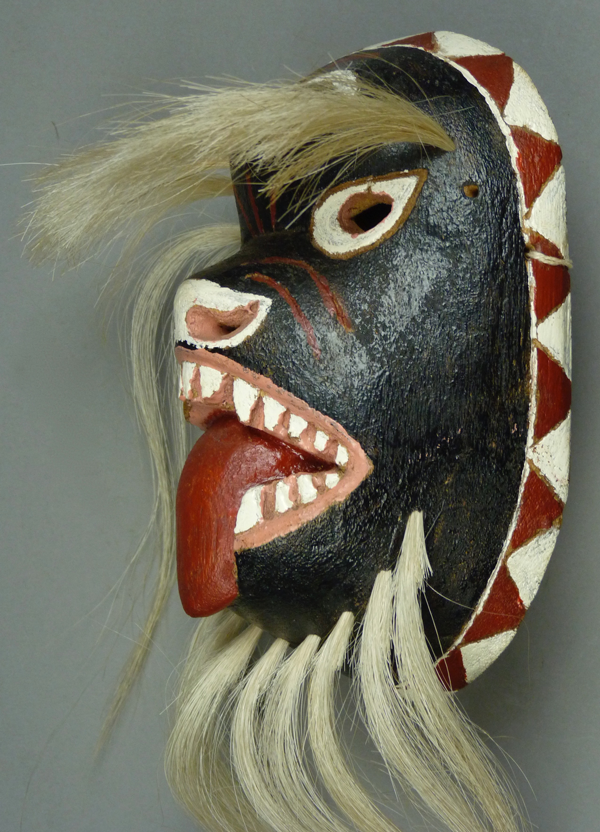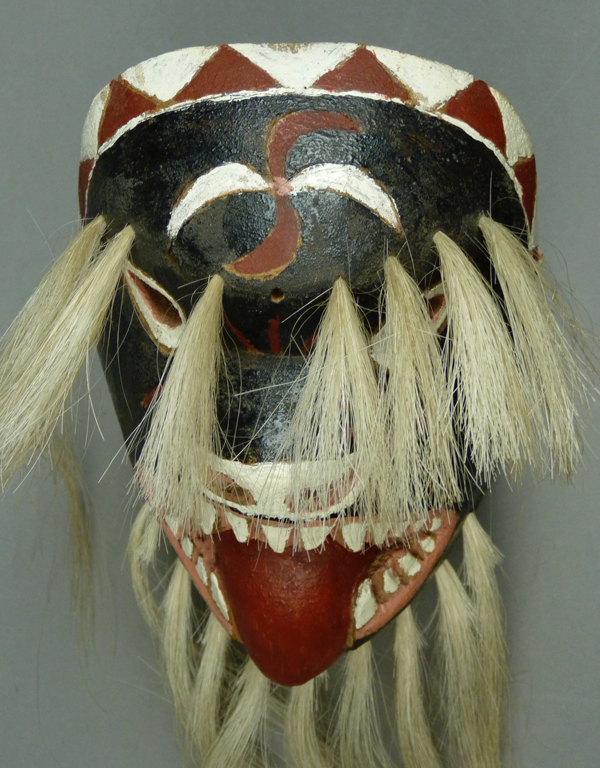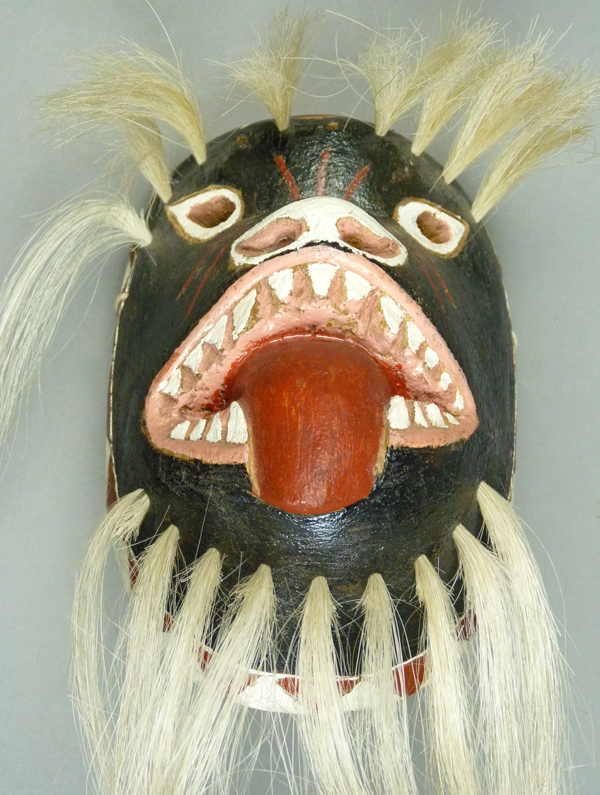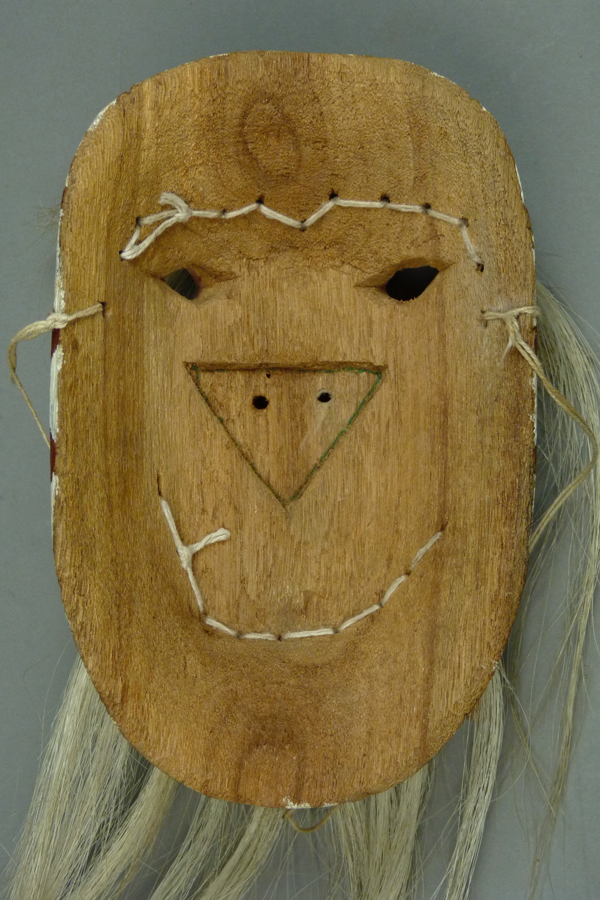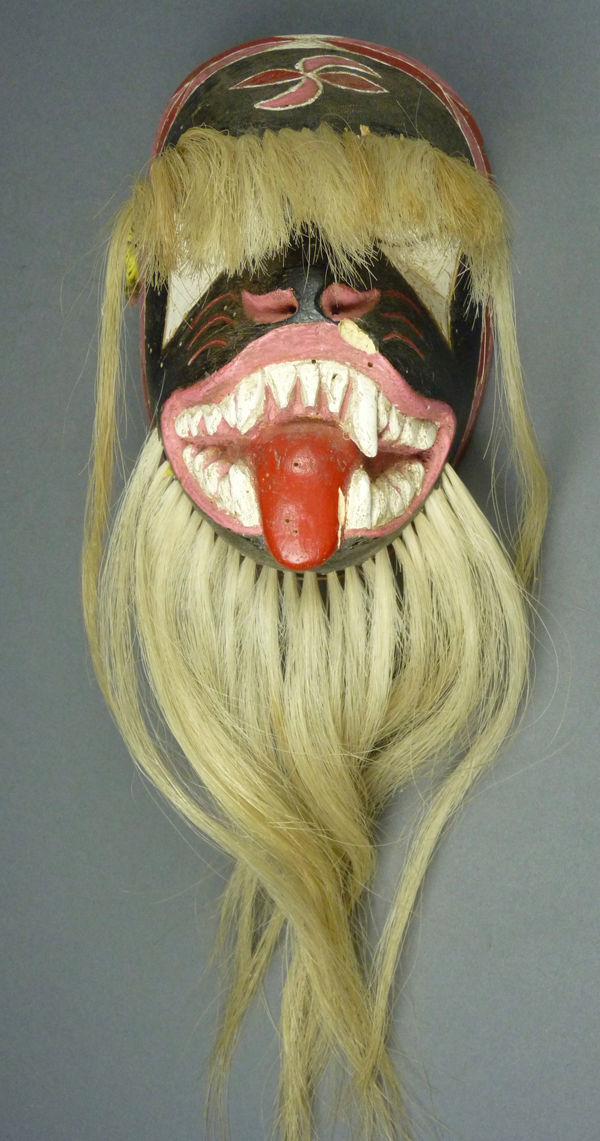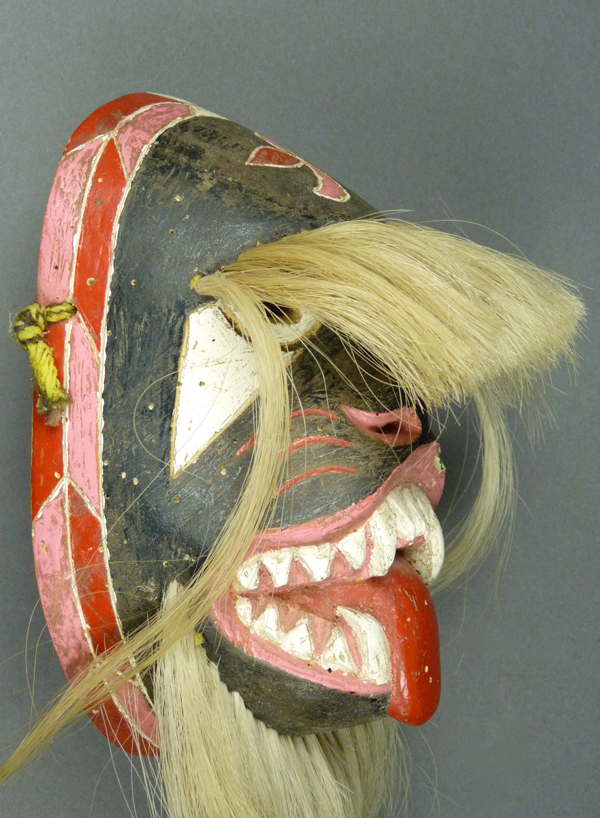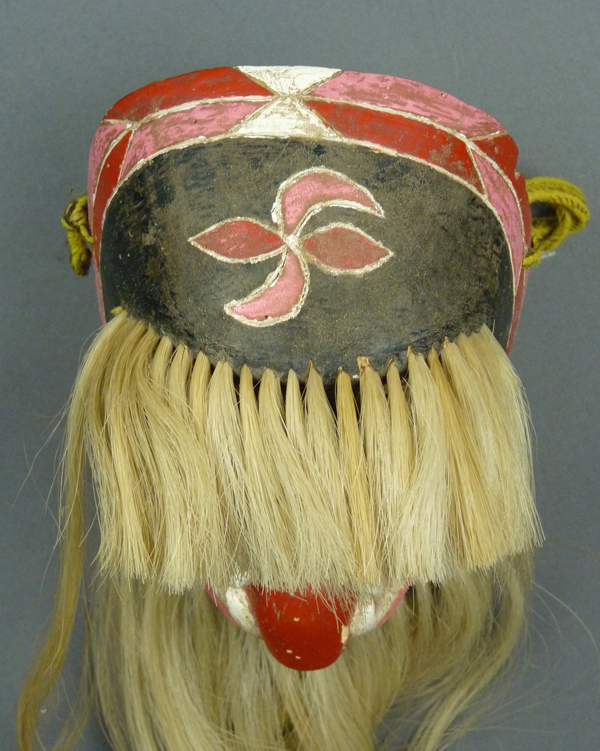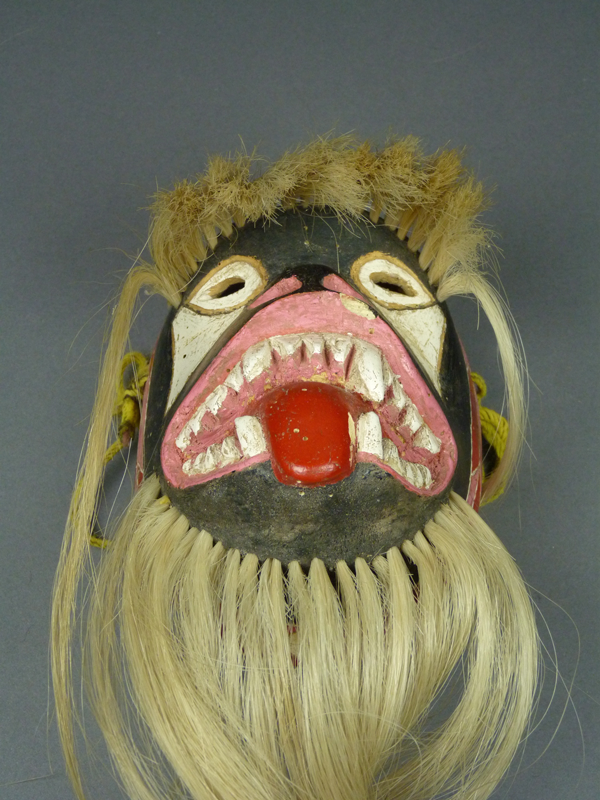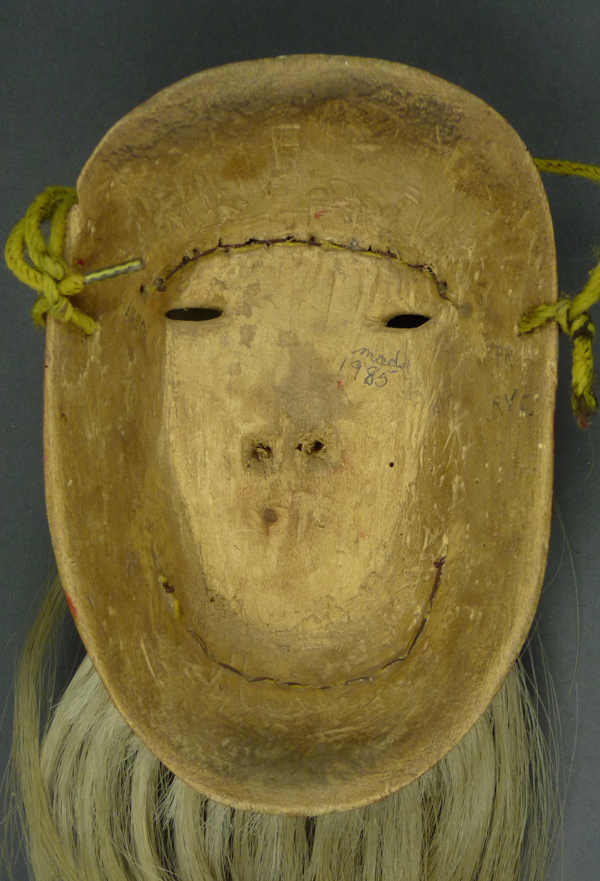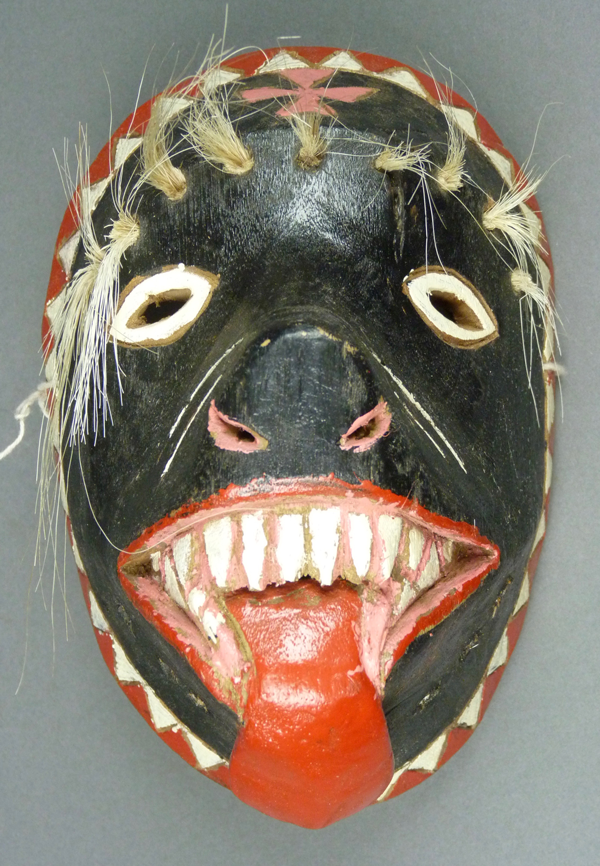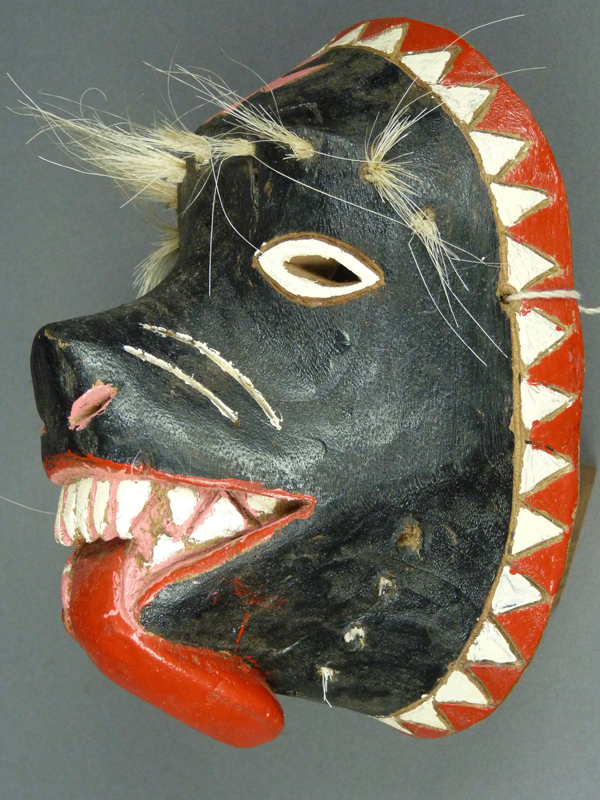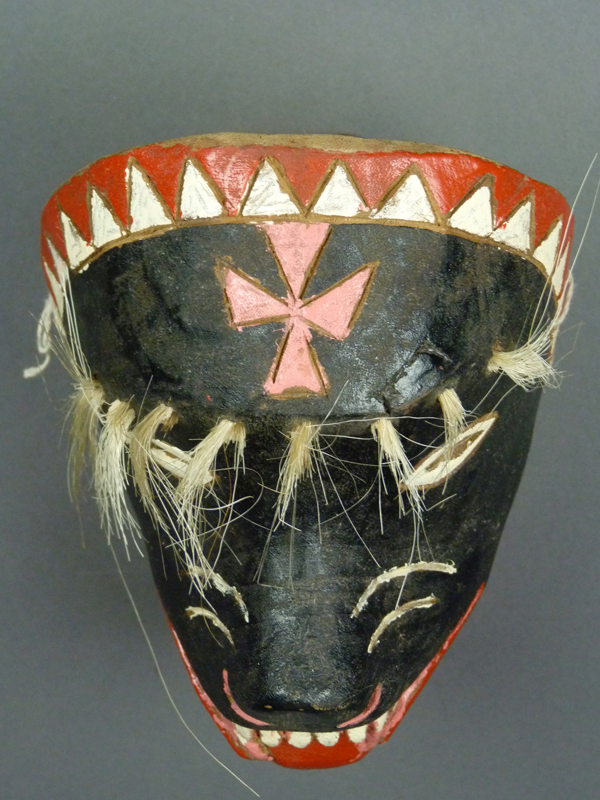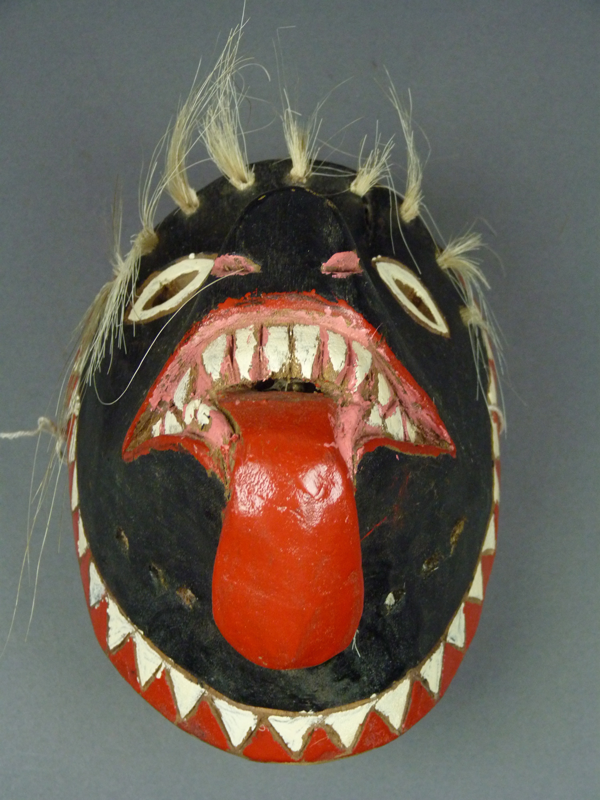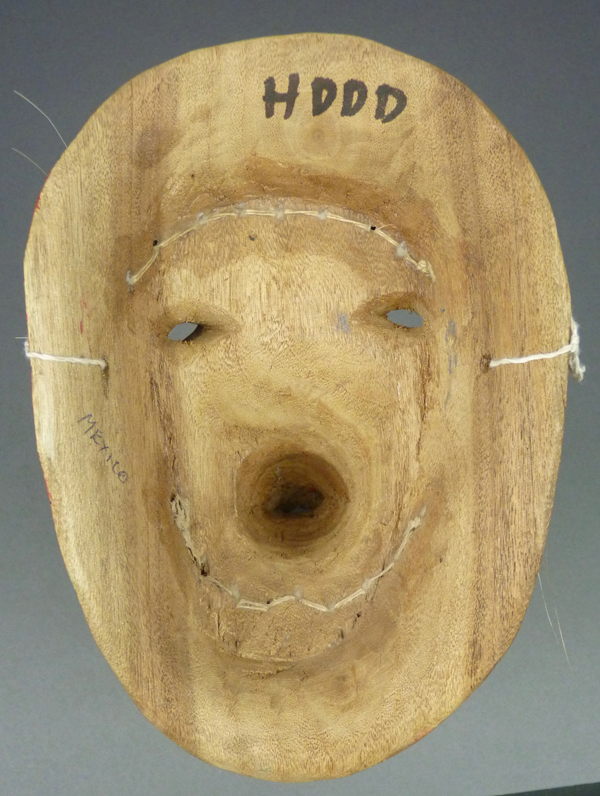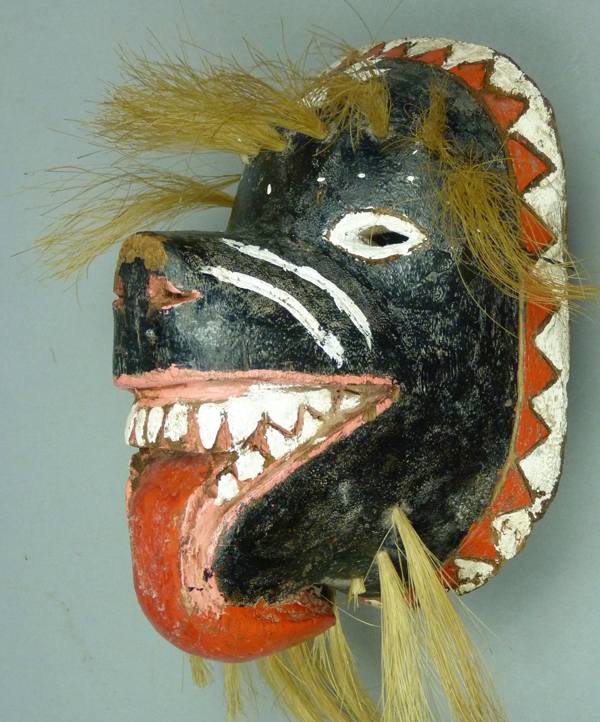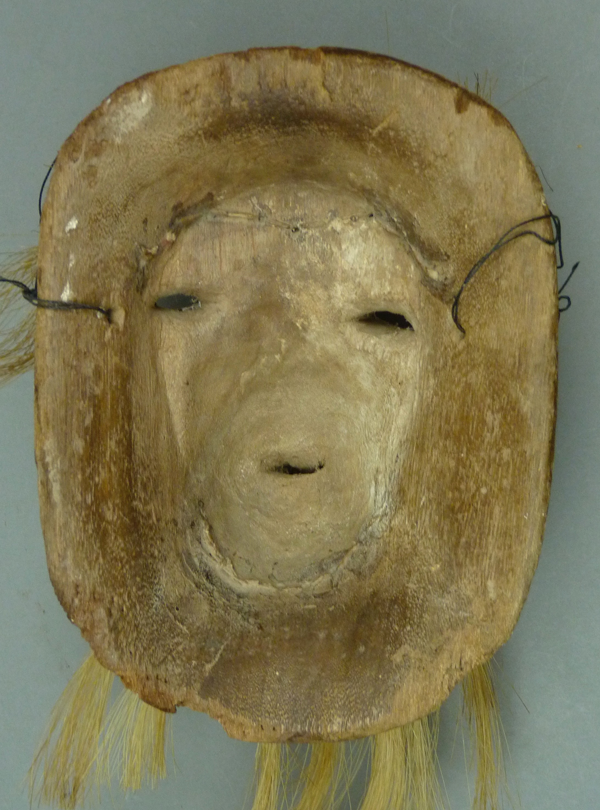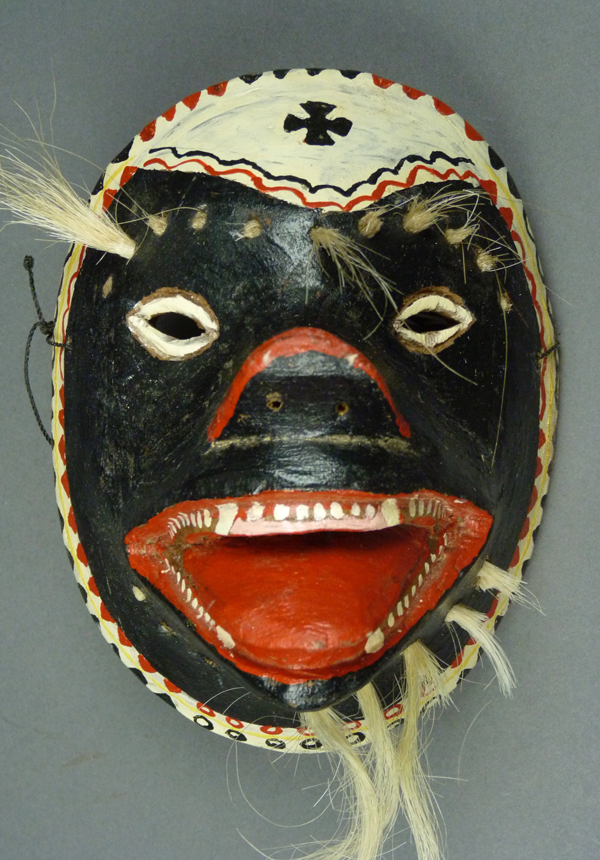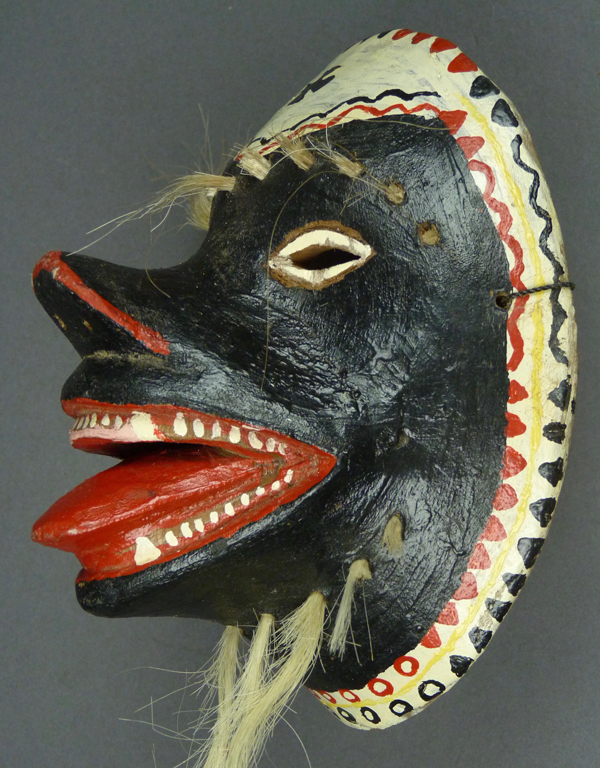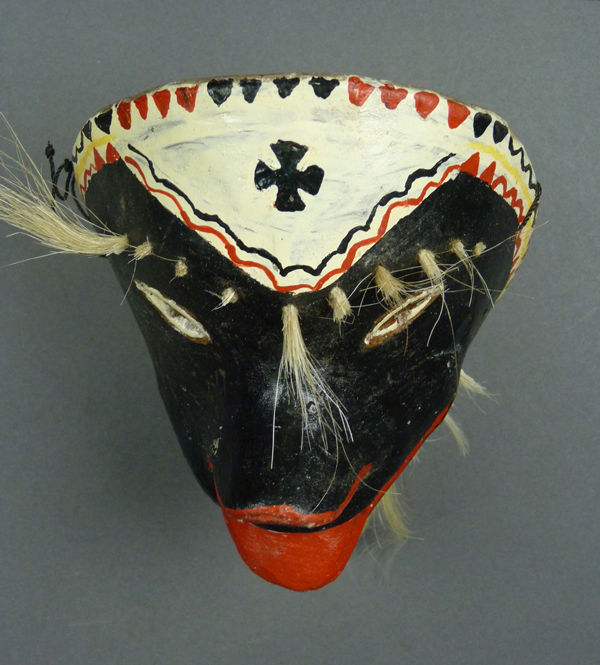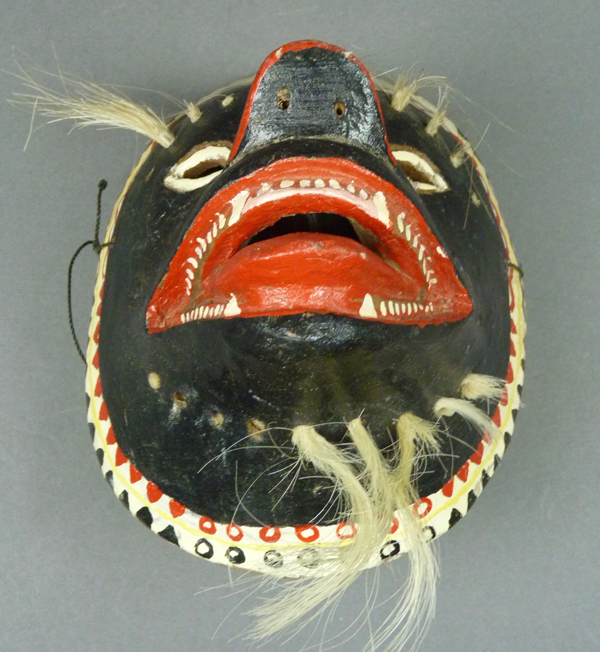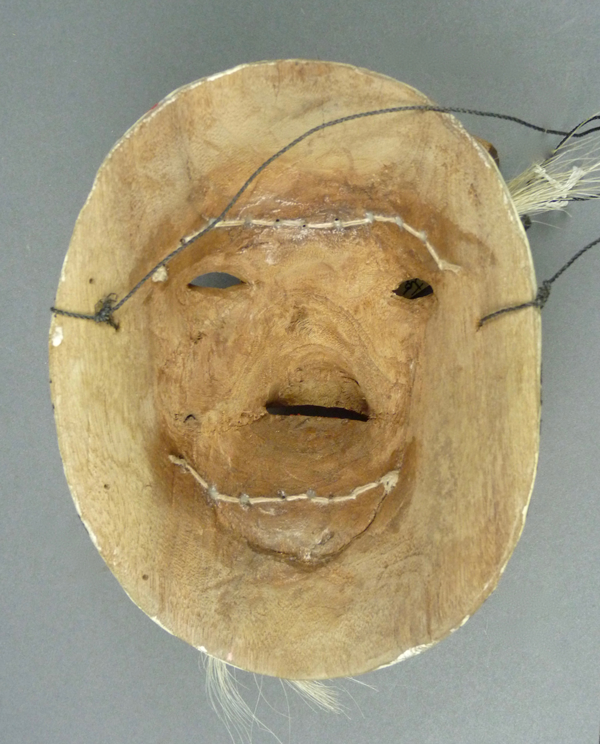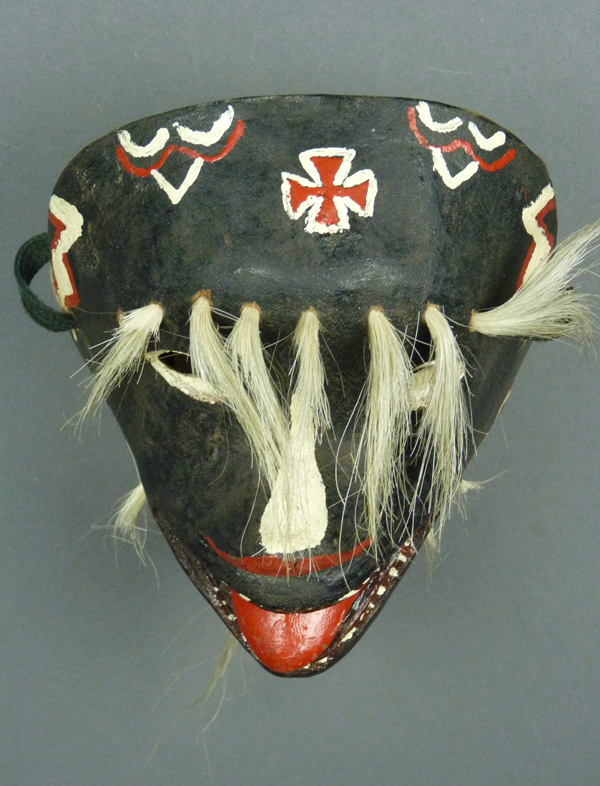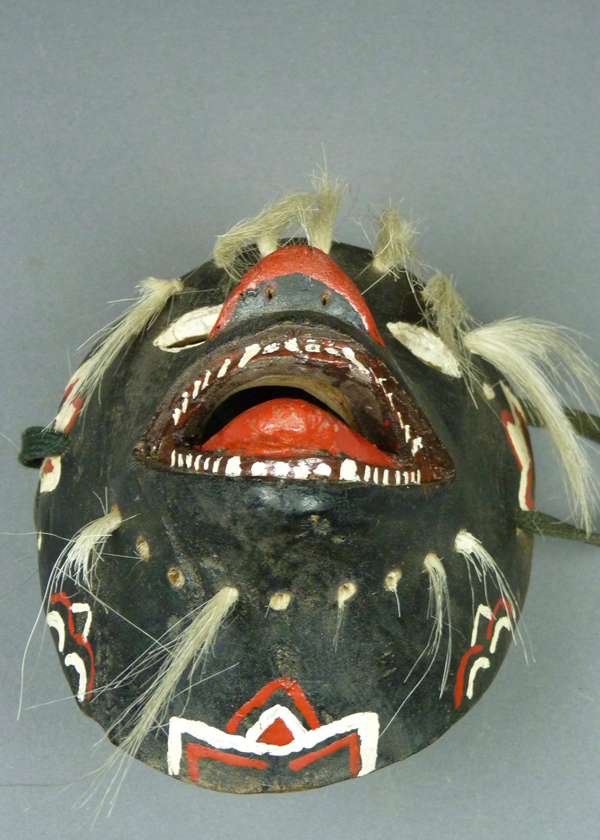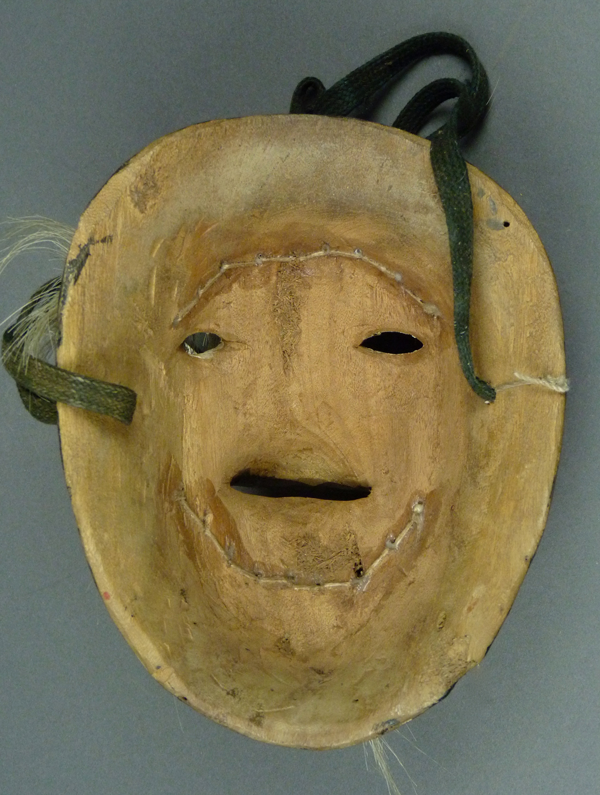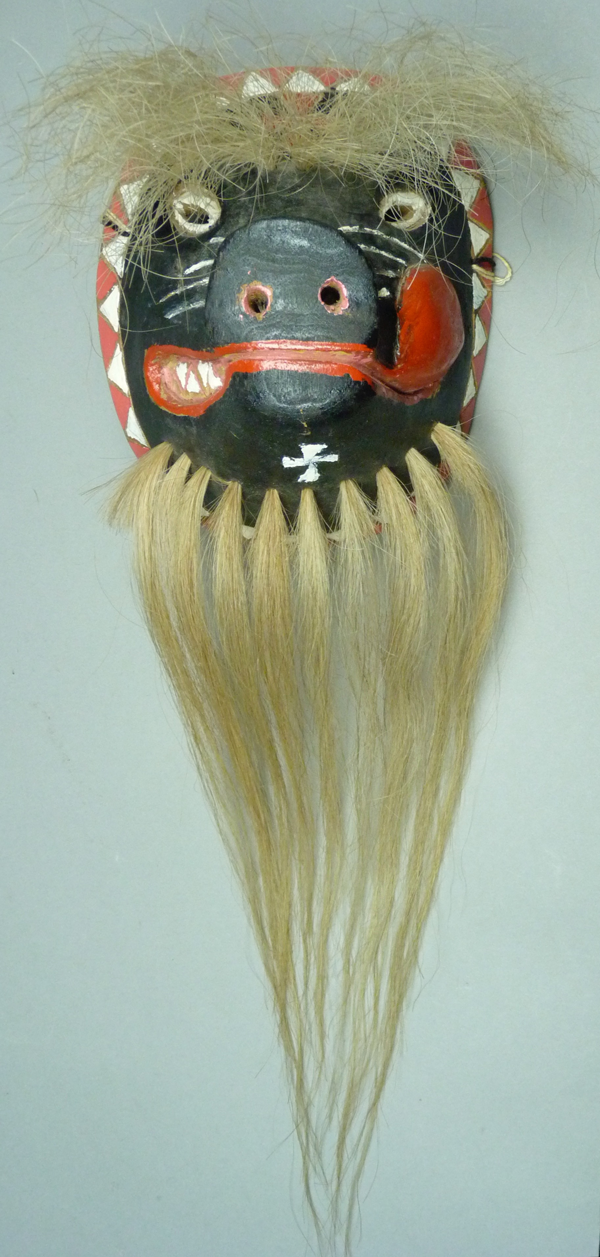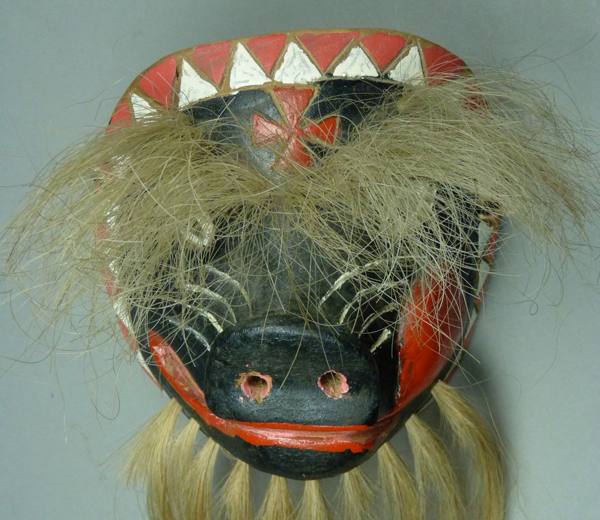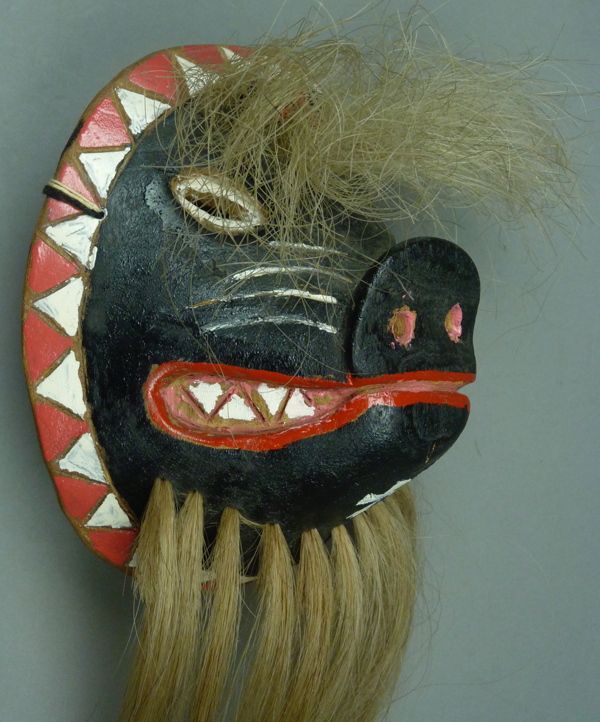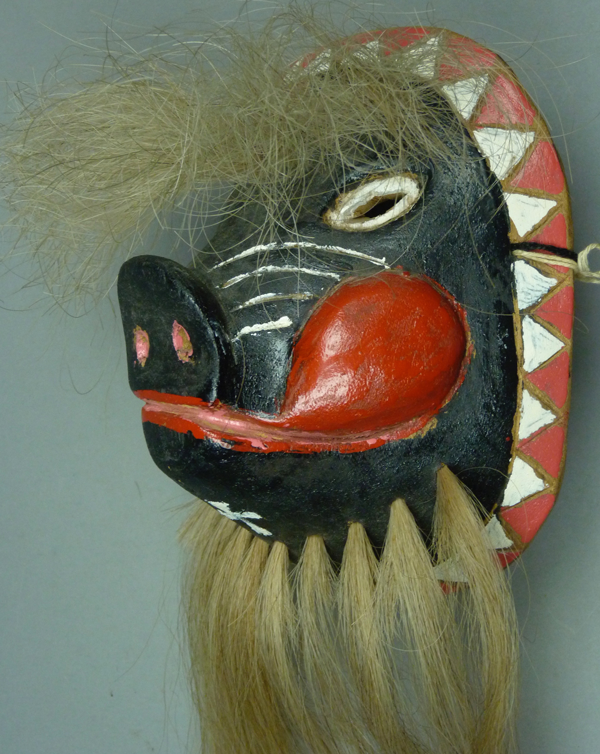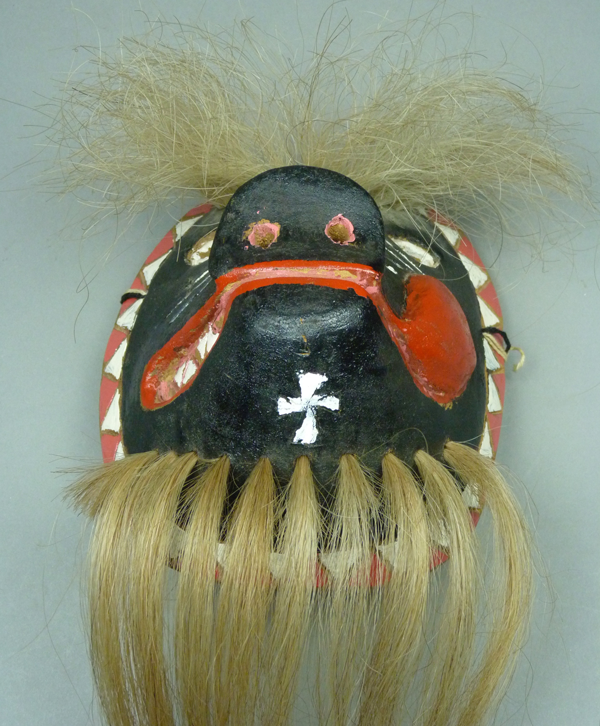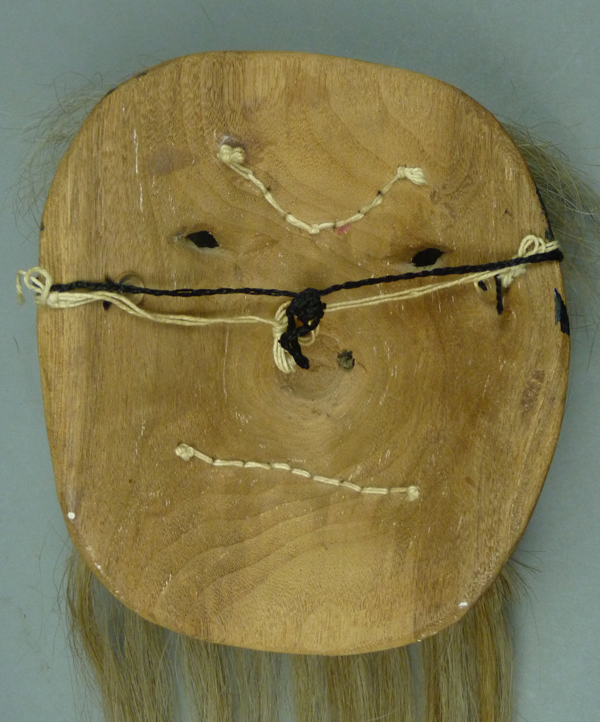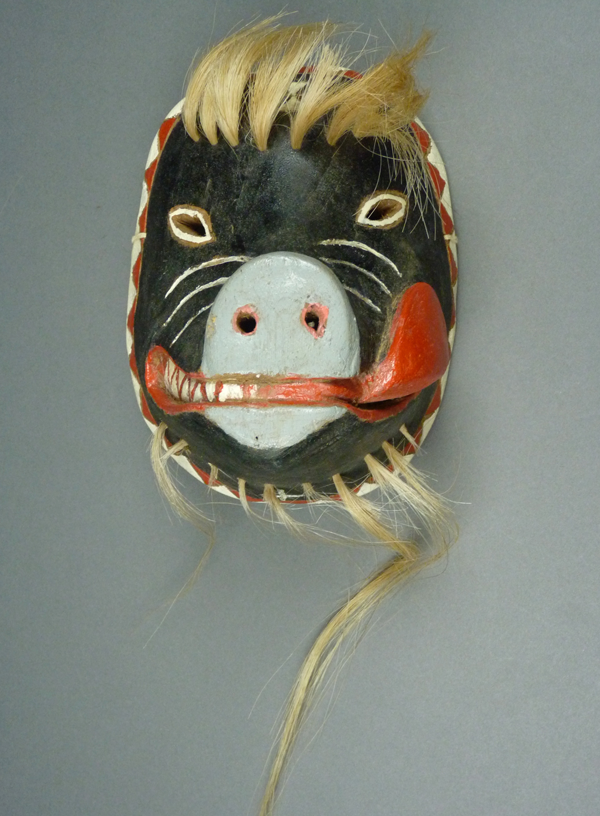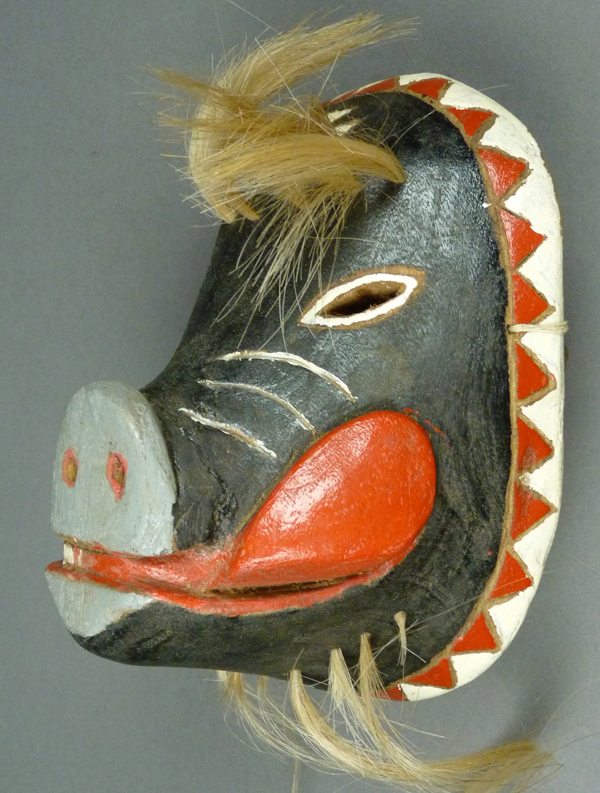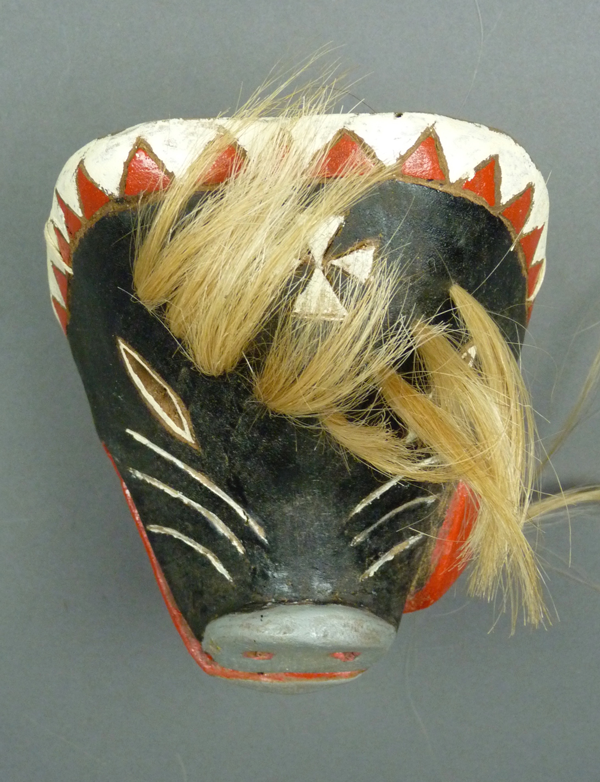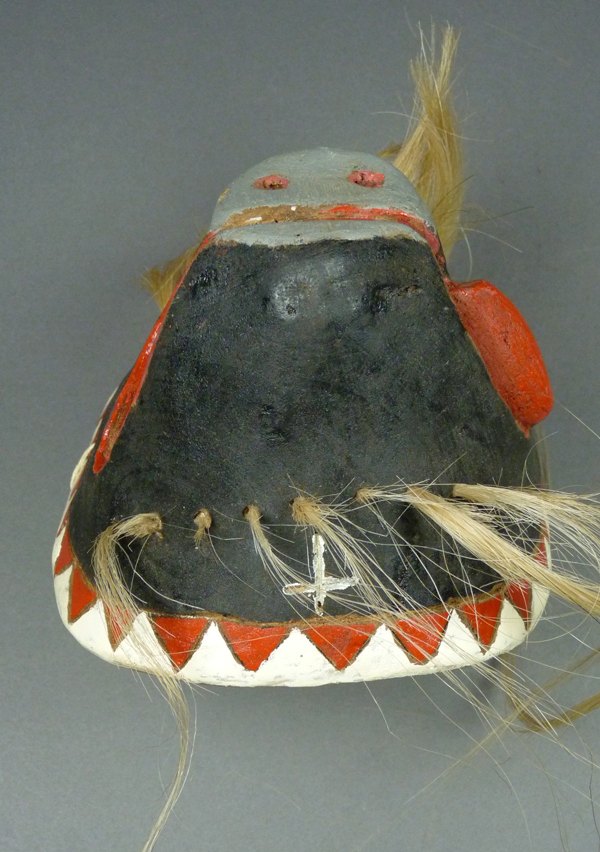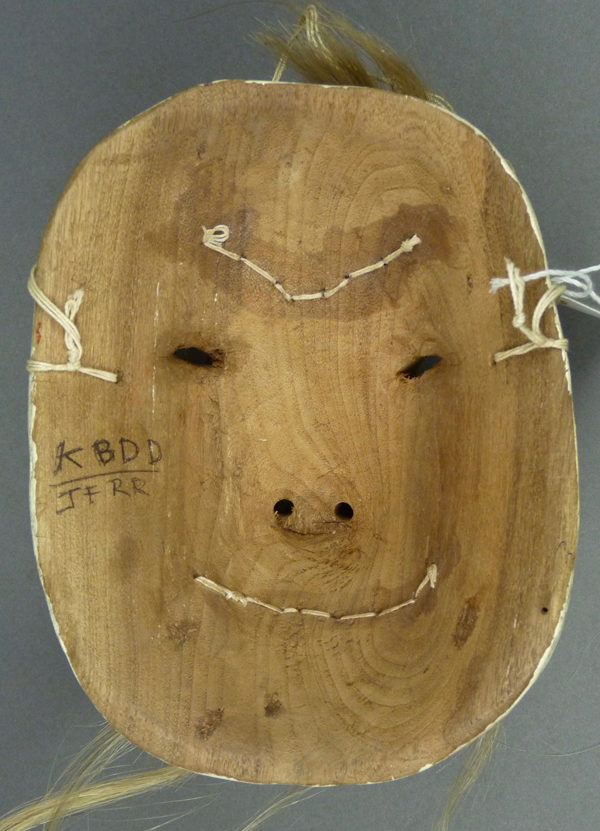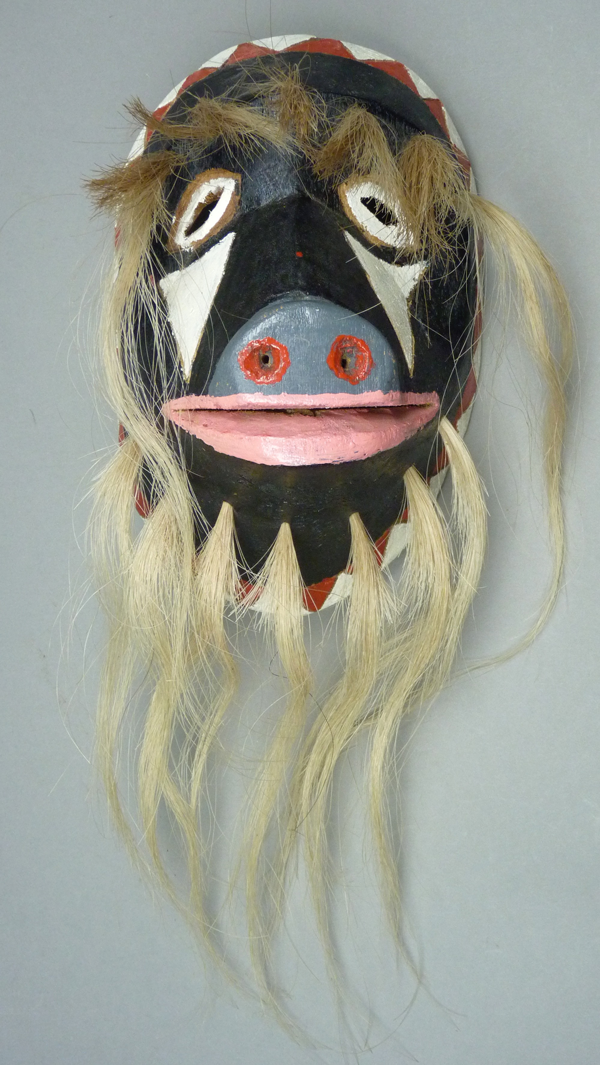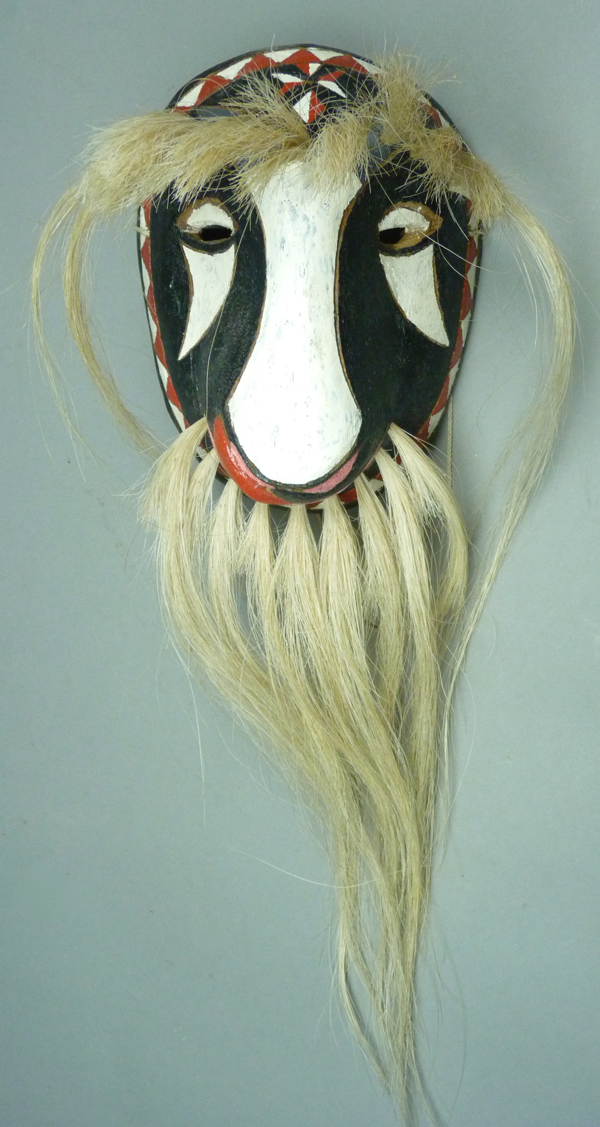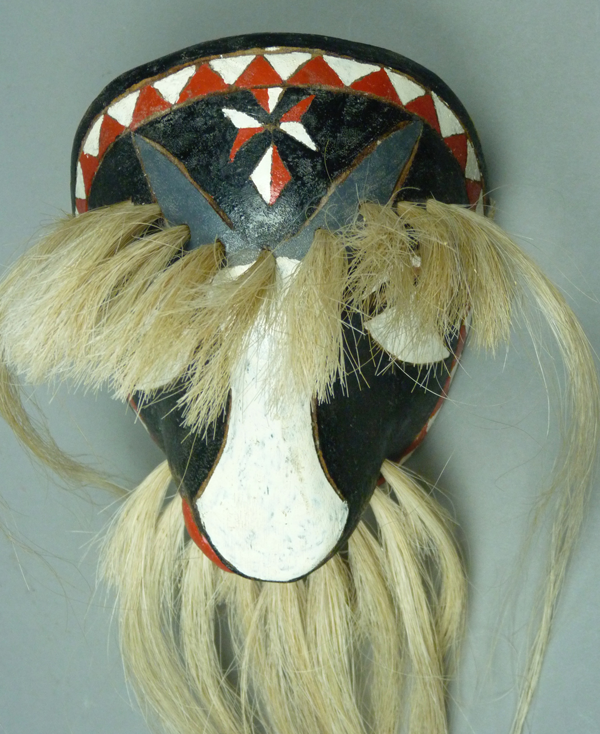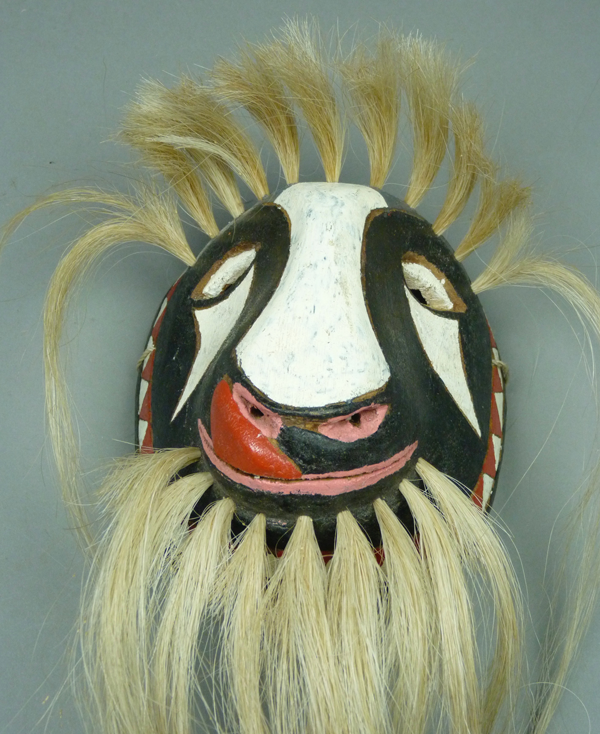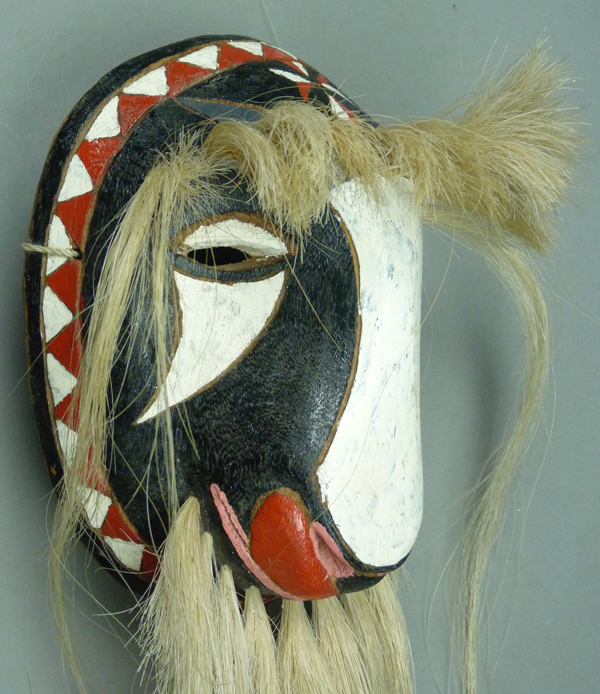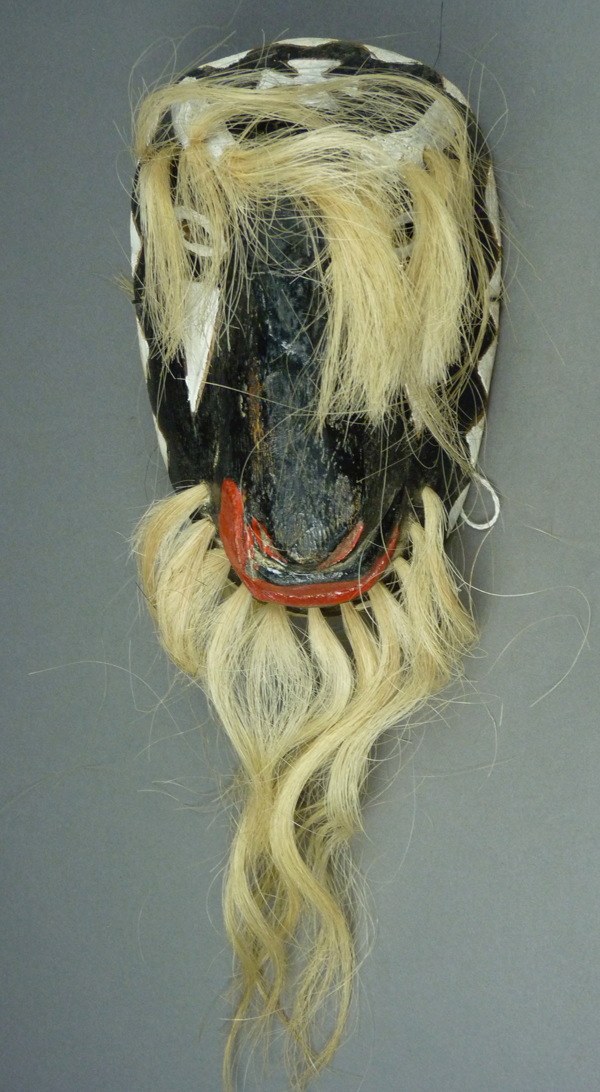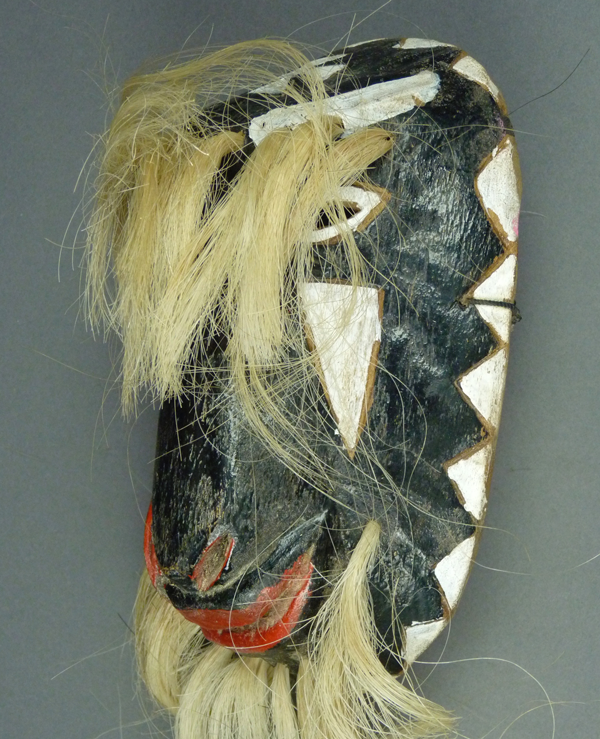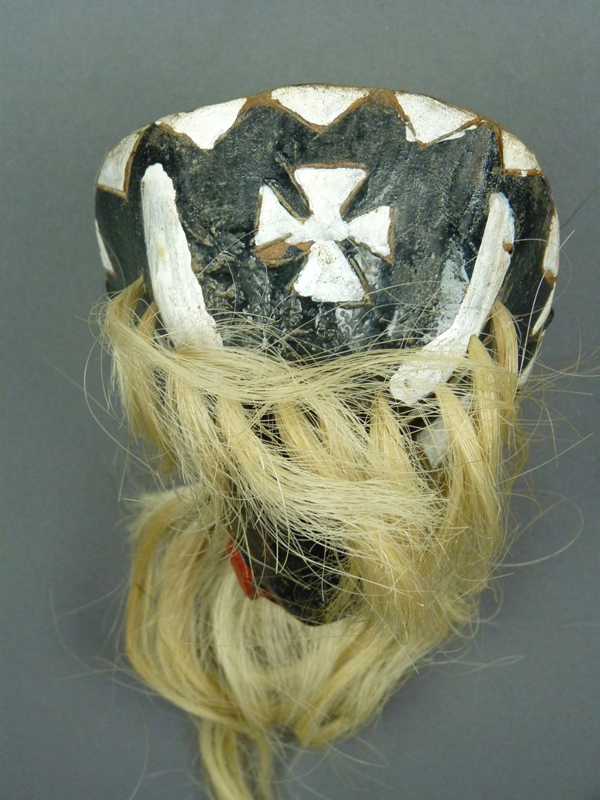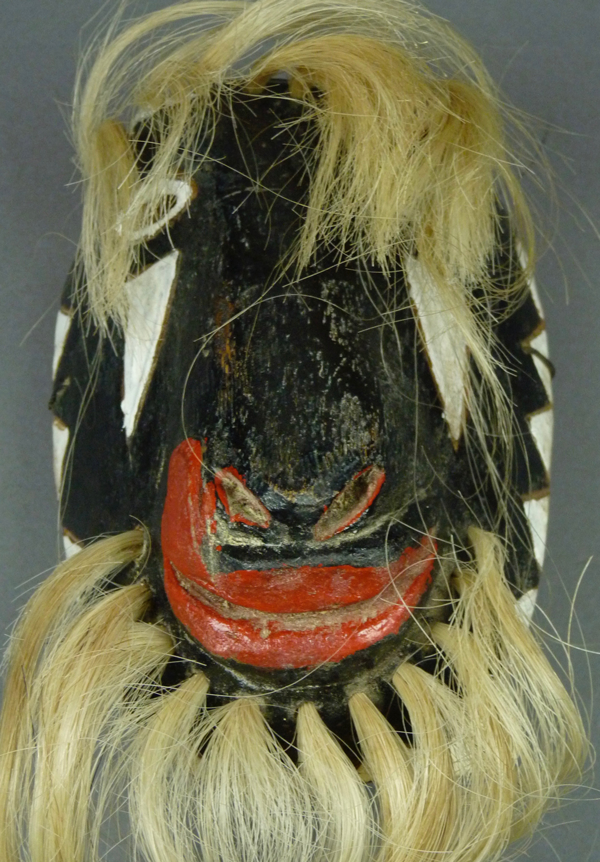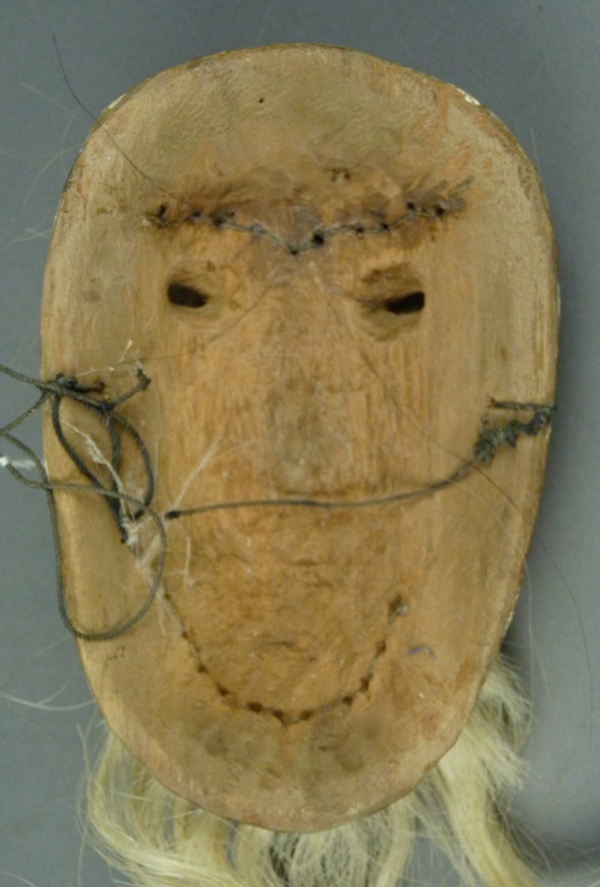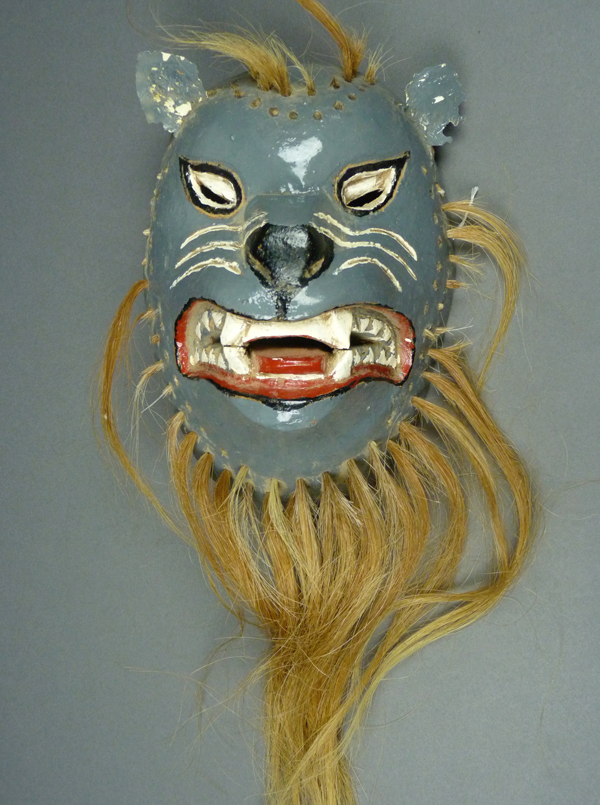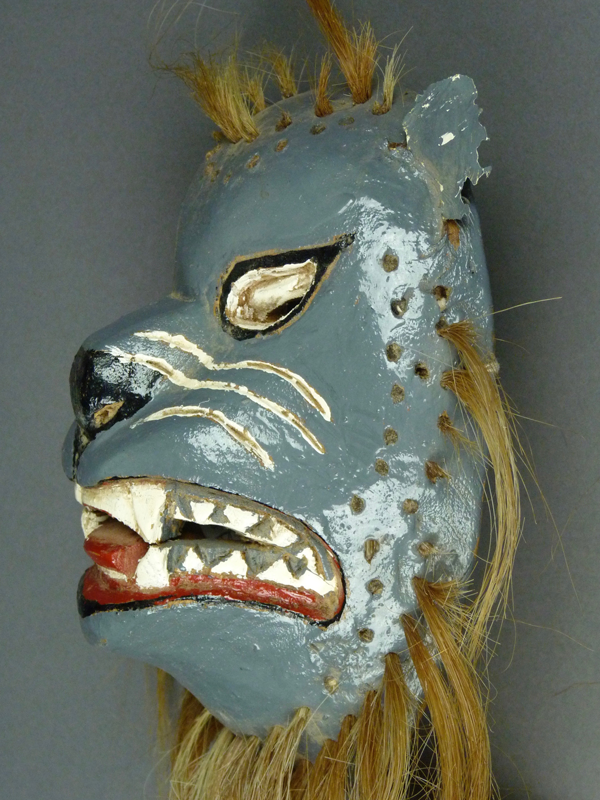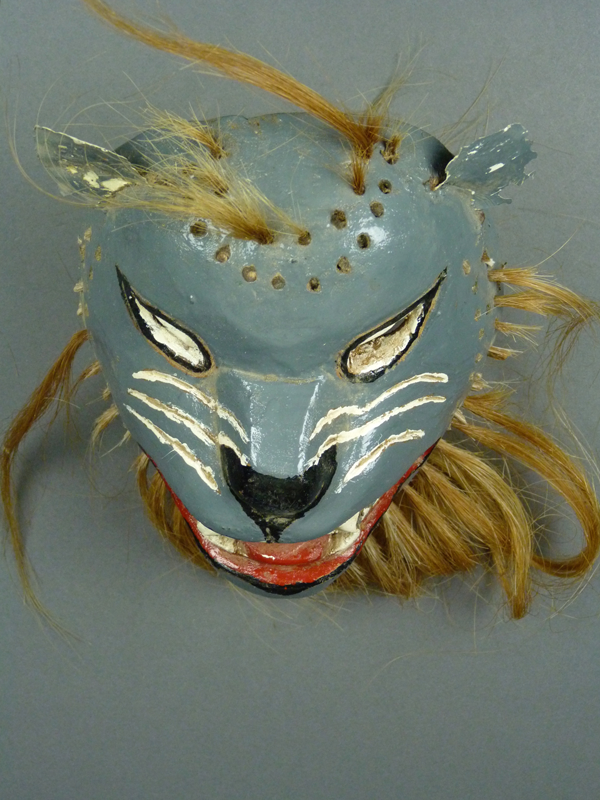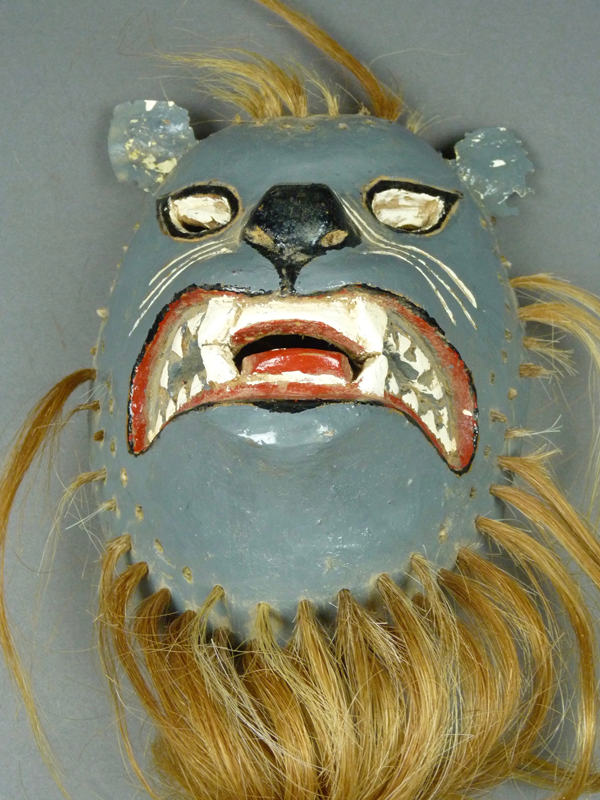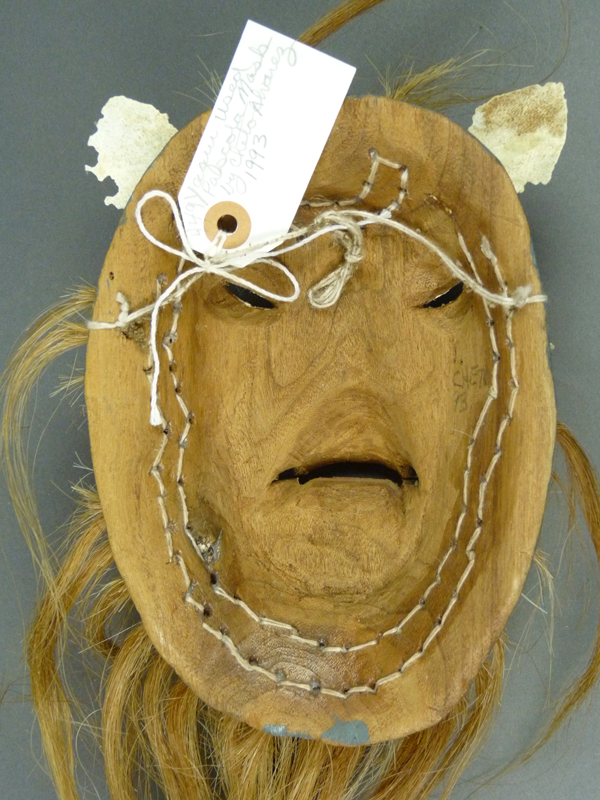Last week I introduced you to Inez “Cheto” Álvarez, a Yaqui mask maker from Potam, Sonora. Today’s animal faced masks will expand your experience of his talent. Some are from my collection and the rest are from the collection of Barney Burns and Mahina Drees Burns.
It seems that Cheto developed specific designs for his animal Pascola masks, so that he made at least several copies of each design. I will begin with one from my collection that I bought on EBay™ in 2002. The seller reported that she had purchased this Canine mask in Tucson, Arizona in 1985, it had been made in Sonora, and she did not know the name of the carver. My friend Tom Kolaz immediately recognized this as a known design by Cheto Álvarez.
This is a Canine Pascola mask with an extended tongue and numerous sharp teeth.
The rim design is generic. The forehead cross, which reminds one of similar designs seen on Rodríguez masks, is also one of Cheto’s favorites.
There is no chin cross. The hair on the forehead and chin is on the thin side, not as dense as one might expect on a danced mask.
An extended tongue is a favorite design feature on Cheto’s masks, and of course we have seen numerous examples of similar tongues on Rodríguez masks.
This was a made for sale mask, and there is no evidence of wear or use. On the other hand, we do find this shallow triangular recess for the dancer’s nose, so shallow that it seems more symbolic than functional.
At the time of collection by Barney Burns and Mahina Drees, the next canine Pascola mask was identified by the seller as a mask by Preciliano Rodríguez Cupis. However it is a near duplicate of of the first mask. It has almost the same forehead cross. Unlike its near twin, this one appears to have been heavily danced.
The rim design should look familiar, as we have seen it on masks made by Preciliano Rodríguez Cupis. It is also a known Cheto variant.
Furthermore, this forehead cross also resembles those of Preciliano. One can begin to imagine why it was attributed to that carver.
The triangles under the eyes are clipped at the upper corners, a feature that I don’t recall seeing on the masks of any carver. My near duplicate doesn’t have triangles under the eyes, and Cheto doesn’t usually install such triangles on animal masks. The Rodríguez carvers do frequently include the triangles on animal masks. We are looking at a mask that was probably altered.
The brow and chin hair bundles are extraordinarily dense. Neither Cheto nor the Rodríguez carvers routinely installed so many hair bundles, although there were other Potam carvers who had such a tendency—Manuel Centella Escalante and Alejandro Reyes Alegria. We have seen one other mask with such remarkable hair, an oversized Canine Pascola mask that was attributed to Jesús Rodríguez Muñoz (see October 3, 2016 post). I suppose that someone dramatically re-haired this mask.
A notation on the back of this heavily used mask states that it was made in 1985.
A second and slightly different canine Pascola mask from the Burns collection was collected as an anonymous mask without any provenance, and it is an example of another Cheto variation. I have a duplicate of this one as well.
This one has the rim design that Cheto used most often.
The forehead cross is typical for Cheto.
The extended tongue is well carved on this mask.
There is no chin cross.
The staining from use is mild.
For comparison, here is a side view of my duplicate, which was collected by Tom Kolaz in the 1980s.
And here is the back view of this heavily danced mask. Note that this mask and the last have the same modest hair bundles that we found on the first mask.
The back of this mask is heavily stained from use.
The Arizona State Museum in Tucson also has a duplicate in this style.
The next two masks are apparently also dogs, but this variation is unfamiliar to me, and to Tom Kolaz. They were collected separately, each said to be the work of Cheto Álvarez, so I am accepting this at face value. The backs do look like others by Cheto, as does the hair.
This variation has a wonderful turned up nose.
The rim design is unusual and idiosyncratic.
There are small drilled nostrils, unnecessary for air flow in combination with this generous open mouth.
There is no chin cross. The unusual rim design circles the mask.
The back demonstrates moderate wear.
The second mask in this style has equally unusual paint, but it is otherwise identical to the first.
This is such a charming design.
There is that turned up nose again.
The painted decorative elements on this mask are unusual and mysterious.
There is no chin cross on this one either.
The back has significant staining from use.
In his article about Yoeme Pascola masks that were danced in Tucson, Arizona, Tom Kolaz told of seeing about eight Pig-faced masks by Cheto during the early 1980s. Four of these were danced at the Barrio Libre chapel, and the other four were as yet undanced when Tom saw them. I will show you one of the danced masks that Tom collected then, which is currently in my collection. A nearly identical mask from that group is shown in Tom’s article (Kolaz, Thomas M. “Yaqui Pascola Masks From the Tucson Area.” American Indian Art Magazine, Vol. 11, No. 1, 38-45. Winter, 1985). Like the canine masks, these pigs have a playful and endearing design.
The most characteristic of Cheto’s favorite features is the tongue extending to one side of the mouth.
Cheto copied Manual Centella’s cross of four triangles, but almost invariably the four points are misaligned, and sometimes this is blurred by added paint that joins the triangles into a solid cross.
But what a brilliant mask this is, such a charming pig.
And from the left side one sees this enormous extended tongue.
There is a second misaligned cross on the chin.
This back is very smoothly finished and shows moderate wear.
Barney and Mahina collected a nearly identical pig mask in Vicam Switch, Sonora. It lacked any provenance but appeared to be from the 1980s.
The nose is gray instead of black.
The tongue is essentially identical to the other.
The forehead cross is white instead of red.
The inscribed Christian cross on the chin is like one of the forehead crosses on a human faced Cheto mask in last week’s post.
The back has a storekeeper’s code. Maybe this mask was mildly danced.
Here is another pig Pascola mask by Cheto from my collection. It is less exciting, but notable for the white triangles under the eyes. Maybe it was Cheto who included the triangles on the dog mask with the remarkable hair.
This mask, which was never danced, lacks a forehead cross.
Next I will show some goat masks by Cheto Álvarez.
I found this danced goat Pascola mask in Tucson in the 1990s. Several features are immediately apparent, such as the typical Cheto style forehead cross, the extended tongue licking one side of the mouth, and the typical Cheto rim design.
This top view shows a plain painted band along the rim, a detail favored by Cheto, Manuel Centella, and Preciliano Rodríguez Cupis. On the other hand, this forehead cross design is definitely Cheto’s. On this mask the horns are outlined with inscribed lines.
Here is that characteristic licking tongue.
On this mask, the hot pink paint has had restrained use.
The rim shows staining from significant use.
This next goat mask was collected by Barney Burns and Mahina Drees Burns in Sonora in 1995, after it had been danced for one year.
Although less smoothly carved than the previous goat, this on has a very similar design.
In this instance the horns are carved in relief.
There is that same licking tongue.
There is obvious wear on the back of this mask.
I will conclude this review of the masks of Cheto Álvarez with this unusual canine mask. Does it represent a gray wolf? It looks more like a Léon (lion). It was collected by Barney and Mahina in 1993.
On a good day, Cheto was capable of carving wonderful masks.
This one had several rows of hair, a feature found on León (lion) masks. The dark color is mysterious. Are we to think of this as a lion of the night? I suppose that this represents a gray Mountain lion.
There are double rows of hair on the top, but no forehead cross. The ears are made of leather.
The back has staining from moderate use. The handwritten notation says “Cheto 93” (1993). From the back one can see that there was once a double row of hair that completely circled the face.
Next week we will look at Pascola masks by Hilario Álvarez Mendoza, the step-son of Antonio Bacasewa.

